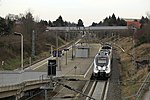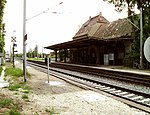Grünau (Leipzig)

Grünau [ɡʁyˈnaʊ̯] is a large housing estate in the western part of Leipzig, Germany, designed in the 1970s and 1980s. It dominates the Stadtbezirk Leipzig-West. In its short history Grünau was at times the most populated district of Leipzig with a maximum of 85,000 inhabitants (1989). Together with Marzahn (Berlin) and Halle-Neustadt, the large housing estate of Grünau was one of the largest prefabricated housing estates (so-called Plattenbau) of East Germany and is the largest settlement of this type in Saxony. It consists of eight Wohnkomplex (translation: residential complexes, abbreviation WK) with large apartment buildings of the dwelling series WBS 70. Despite the good infrastructure, the population of Grünau declined rapidly after 1990. In 2010, the district lost more than half of its residents and thousands of apartments were demolished. At the same time, due to the increasing aging and the settlement of low-income families, there is a negative trend in the age and social structure of this residential area. Since 2010, the population has slowly increased again.
Excerpt from the Wikipedia article Grünau (Leipzig) (License: CC BY-SA 3.0, Authors, Images).Grünau (Leipzig)
Ludwigsburger Straße, Leipzig Grünau-Mitte (West)
Geographical coordinates (GPS) Address Nearby Places Show on map
Geographical coordinates (GPS)
| Latitude | Longitude |
|---|---|
| N 51.319444444444 ° | E 12.290277777778 ° |
Address
Ludwigsburger Straße 9
04209 Leipzig, Grünau-Mitte (West)
Saxony, Germany
Open on Google Maps









